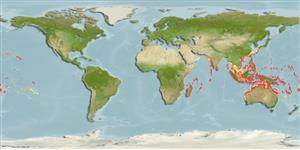Common names from other countries
Issue
Indian Ocean species refers to C. nigripinnis; reference needed (N.Bailly pers.comm., 02/2019).
Environment: milieu / climate zone / depth range / distribution range
Ecologia
marinhas associadas(os) a recifes; intervalo de profundidade 0 - 60 m (Ref. 5222), usually 3 - 15 m (Ref. 9710). Tropical; 34°N - 30°S, 33°E - 131°W (Ref. 5222)
Pacific Ocean: eastward to French Polynesia and the Pitcairn Islands, and to Christmas Isalnd in the Indian Ocean
Comprimento de primeira maturação / Tamanho / Peso / Idade
Maturity: Lm ?, range 17 - ? cm
Max length : 28.0 cm TL macho/indeterminado; (Ref. 5222)
Espinhos dorsais (total) : 9; Raios dorsais (total) : 14 - 16; Espinhos anais: 3; Raios anais : 8 - 9. This species is distinguished by the following characteristics: greatest body depth 2.7-3.1 in standard length; body scales ctenoid except cycloid scales ventrally on abdomen; rounded caudal fin; pelvic fins usually not reaching the anus, 1.8-2.2 in head length Colour of body reddish brown anteriorly, dark brown posteriorly; caudal fin with 2 white to bluish white bands that converge posteriorly (Ref. 90102).
Adults inhabit clear, shallow waters of outer reef areas, in lagoons, back-reef areas, and on the reef-top. As solitary individuals (Ref. 90102), they prefer healthy coral reef in shallow areas, and are therefore greatly affected by reef degradation (Ref. 89707). They feed on small fishes (68%) and crustaceans. Because of its small size, the darkfin hind is not of much interest as a food fish (except perhaps to subsistence fisheries), but it does well in an aquarium and may find a market as an aquarium fish. They are caught with hook-and-line, gill nets, and in traps (Ref. 39231). Minimum depth reported taken from Ref. 128797.
Ciclo de vida ou comportamento de acasalamento
Maturities | Reprodução | Spawnings | Egg(s) | Fecundities | Larvas
Protogyny is unconfirmed for this species (Ref. 103751).
Heemstra, P.C. and J.E. Randall, 1993. FAO Species Catalogue. Vol. 16. Groupers of the world (family Serranidae, subfamily Epinephelinae). An annotated and illustrated catalogue of the grouper, rockcod, hind, coral grouper and lyretail species known to date. Rome: FAO. FAO Fish. Synop. 125(16):382 p. (Ref. 5222)
Status na Lista Vermelha da UICN (Ref. 130435)
CITES (Ref. 128078)
Not Evaluated
Ameaça para os humanos
Harmless
Uso pelos humanos
Pescarias: pesca de subsistência; Aquário: Potencial
Ferramentas
Relatórios especiais
Baixar XML
Fontes da internet
Estimates based on models
Preferred temperature (Ref.
115969): 25.2 - 29.3, mean 28.4 (based on 3224 cells).
Índice de diversidade filogenética (Ref.
82804): PD
50 = 0.5000 [Uniqueness, from 0.5 = low to 2.0 = high].
Bayesian length-weight: a=0.01230 (0.00759 - 0.01994), b=3.04 (2.90 - 3.18), in cm Total Length, based on LWR estimates for this species & Genus-body shape (Ref.
93245).
Nível Trófico (Ref.
69278): 4.0 ±0.69 se; based on food items.
Resiliência (Ref.
120179): Elevada, tempo mínimo de duplicação da população menor que 15 meses (Preliminary K or Fecundity.).
Fishing Vulnerability (Ref.
59153): Low vulnerability (14 of 100).
